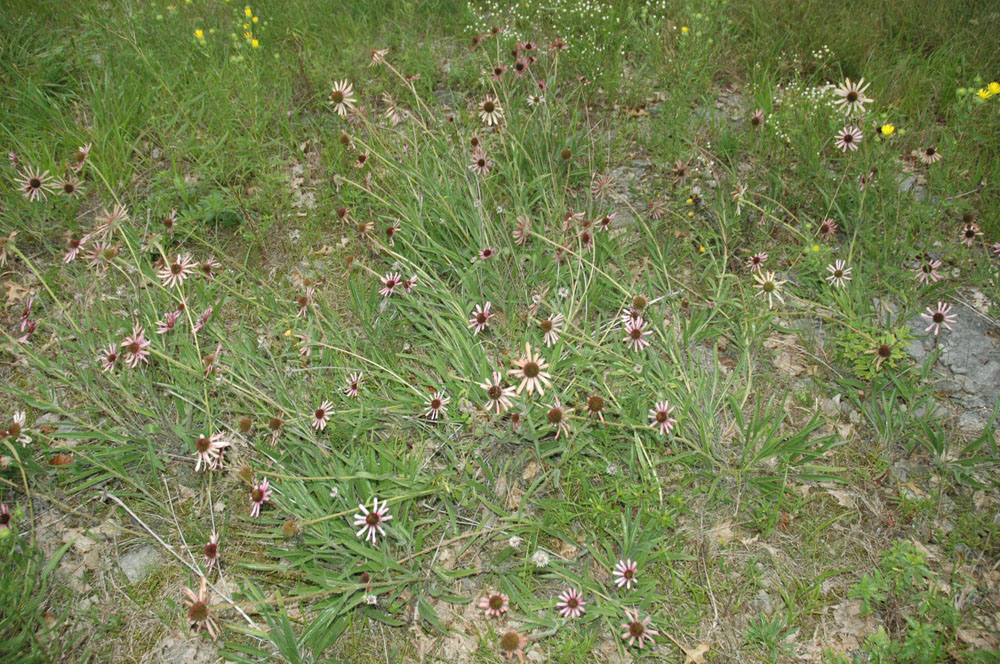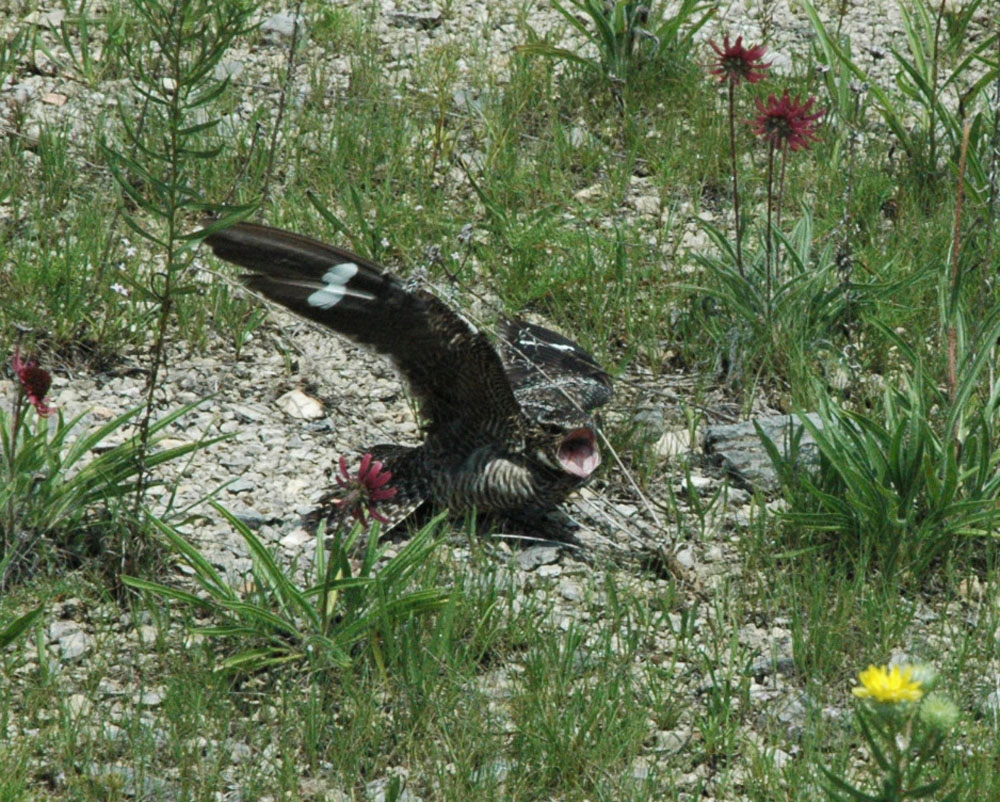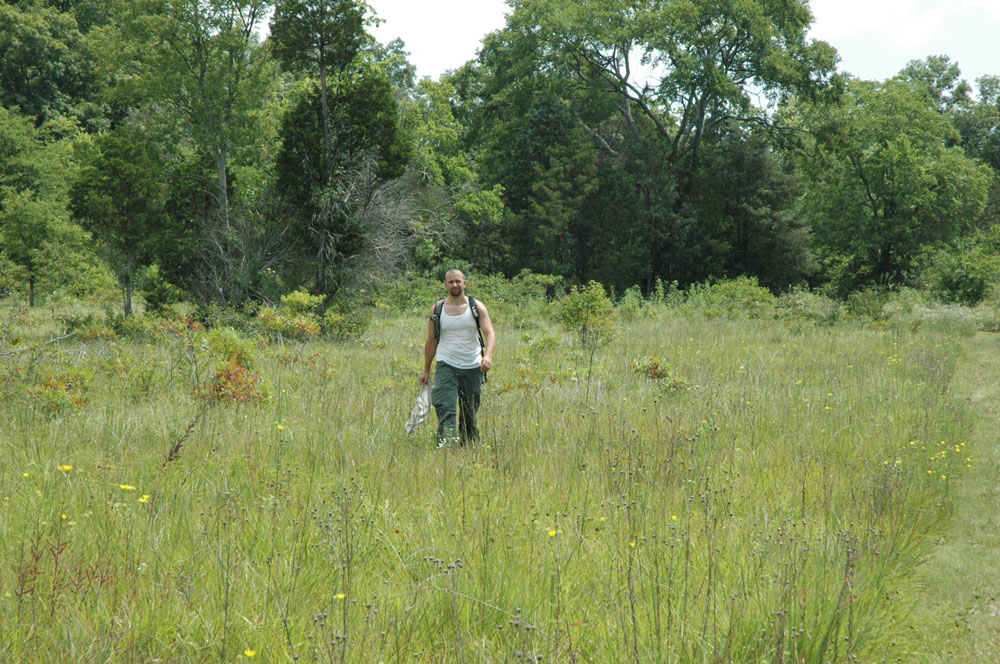The 2009 William H. Cross Expedition
Cedar Glades of central Tennessee, 20-27 July 2009
by Joe MacGown, 28 July 2009
The 2009 Cross Expedition took place from 20 to 27 July and focused on cedar glade habitats located in the Central Basin of central Tennessee. We stayed in a cabin (cabin 2) at the Cedars of Lebanon State Park in Wilson County. During the week we collected at cedar glade, open grassland barrens, and cedar/hardwood forest habitats at Cedars of Lebanon State Park, Cedars of Lebanon State Forest (Wilson Co.), Vesta Glade Natural Area (Wilson Co.), Couchville Glade State Natural Area (Davidson Co.), and several glades in Rutherford County. The entire area is underlain by karst geological formations, in which caves are plentiful and sinkholes are common. Overall, the vegetation is very similar to Black Belt Prairie habitats in Mississippi and Alabama, but instead of chalk beneath the soil, there is limestone. Cedar glades are known to support high plant diversity, and several endemic plants are known to occur there. On a previous trip to the glades in June of 1997, we collected several interesting insect species, despite cool, wet weather.
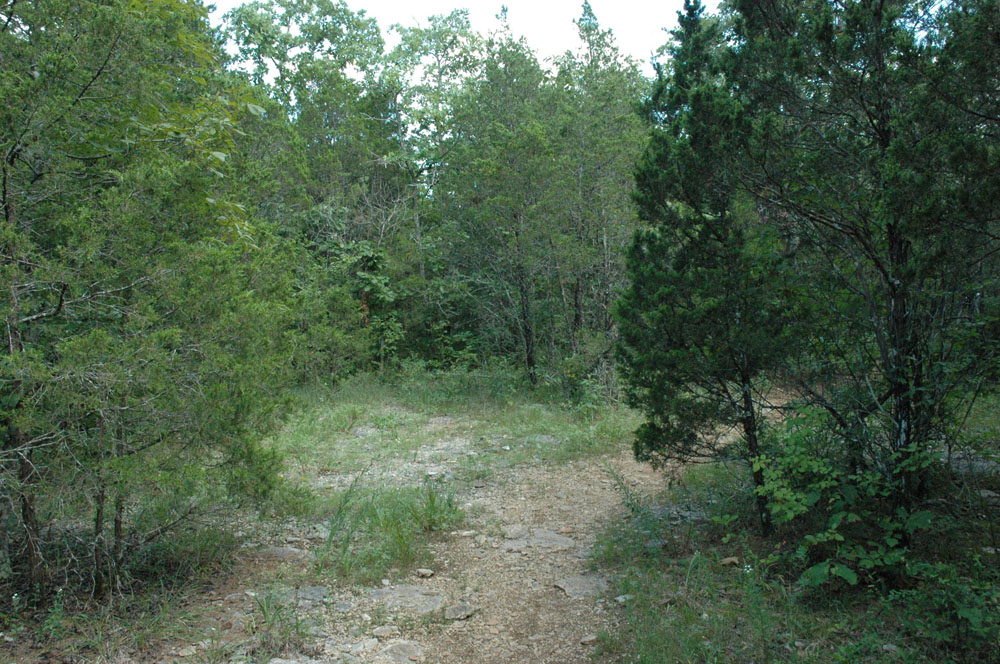
Open rocky area in cedar glade
Participants of this year’s trip included Richard Brown (MEM director), Terry Schiefer (MEM curator), Joe MacGown (MEM Research Technician), JoVonn Hill (MEM Research Associate), Sangmi Lee (MEM Research Associate), Beverly Smith (Noxubee Wildlife Environmental Education Center – Director), and Clare Scott (University of Florida, Ph.D. student studying arctiid moths). Nadeer Youssef and Josh Basham, from Tennessee State University also collected with us on two nights.
Monday, 20 July 2009
Terry, JoVonn, Beverly, and I arrived at the State Park at about 3 PM on 20 July 2009, which was an hour earlier than registration. While we waited for check in time, we collected a bit around the cabin (36°04’52”N 86°18’55”W). We found several ants crawling on the ground right in front of the cabin including some yellowish orangish colored Forelius, probably mccooki, Pheidole sp., Neivamyrmex sp. and several others. Of these, the Neivamyrmex, one of our army ant species, was perhaps the coolest find. We did not realize that they were army ants at that time, as we only picked up a couple of specimens, and it wasn't until a couple of mornings later when they were forming strong lines that JoVonn noticed that they were, in fact, army ants. During this time, Terry put up a Lindren funnel trap in the sloped cedar hardwood forest behind our cabin.
While we were waiting, Clare Scott pulled in. Clare’s research focused on the arctiid genus Crambidia,which are lichen feeding moths. She came on the trip to hopefully collect specimens in her study group, to learn more about our methods of collecting and spreading the wings of lepidopteron, and in general, learn what she could about moths from Richard, who has a vast knowledge of Lepidoptera.
Finally, check in time came around, and we unloaded the vehicles. Richard and Sangmi arrived soon thereafter, and we made plans for the rest of the day. Richard put up a sheet with a blacklight and a mercury vapor lamp in the woods behind the cabin.
JoVonn, Terry, Beverly, and I went to the Cedars of Lebanon State Forest, which is adjacent to the park, to collect and scout for potential blacklight sites. We headed west out out the park crossing Hwy 231 into the state forest. Our first stop, Site 1, was a glade along the north side of the road at 36°05’44”N 86°21’56”W. The entranceways to the glade were blocked by large rocks to prevent easy access from ATV vehicles. Quite a few flowers were in bloom including gumweed (Grindelia lanceolata), Sebatia angularis, Helianthus sp. and many others. The gumweed was aptly named as evidenced by the gummy, sticky sap that oozed out of the flower heads when pulled apart. Quite a few bees and wasps were present, but the most obvious insects were the grasshoppers (much to JoVonn’s satisfaction).
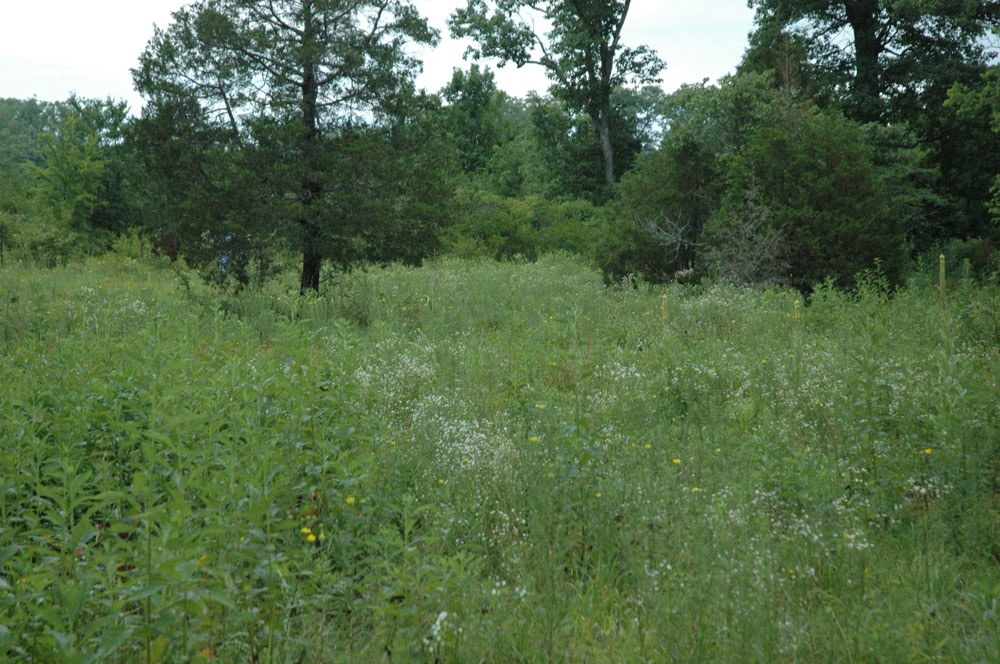
Grassy barrens at Couchville Glades
After leaving site 1, we continued westward until stopping at a more extensive glade area, which we called site 2 (36°05’26”N 86°22’34”W). Although this site was more extensive than site 1, it was also more disturbed, and it looked as though some ATV’s had driven through parts of the area. While collecting we noticed lots of Formica integra, a fairly large red and black ant species, foraging on the ground. Searching under rocks revealed several colonies of this species, and a large colony was found underneath a flat rock that was about 1 meter long.
After collecting and taking some photos, we went back to the cabin to eat a sandwich. After supper we went back to site 2 in the state forest, where we put up four sheets with blacklights. Richard also put out a box trap with blacklight on a wooded ridge at Site 4 (36°05’21”N 86°22’45”W). Collecting was very slow, as temperatures were cool for this time of year, dipping down to about 60° F. We took the sheets down around 10:15 and went back to the cabin to check the sheet there. The cabin sheet was slightly more active, probably due to the fact that it was in a more protected depressed area in the woods and because the MV light often pulls in more insects.
Tuesday, 21 July 2009
The next morning, Richard got up early and retrieved the boxtrap, which had quite a few macrolepidoptera, but not too many micros. He spent part of the morning sorting the trap, then Sangmi, Clare, and he spent most of the rest of the day spreading moths.
That morning, Beverly stayed in the state park, collecting along the roadside and on some of the trails. Terry, JoVonn, and I went back to the state forest near the area where we had collected the previous day. We first stopped at the state forest office and picked up a couple of maps. On the way out of the parking lot, we were flagged down by a woman named Rita Venable who worked with the Tennessee Department of Environment and Conservation. She introduced herself and asked if we were involved in the discovery of Mitchell’s Satyr in Mississippi. She was excited to learn that it was Terry who had discovered the populations in Mississippi.
Terry and I set up one malaise, one Lindgren funnel trap, and one barrier trap at site 3 (36°05”44”W 86°21’23”W). The malaise trap was put up at the edge of the cedar glade and the other two traps were placed in the cedar/hardwood forest. JoVonn spent his time collecting grasshoppers and other insects. I also grabbed a few grasshoppers, some cool membracids, and other things.
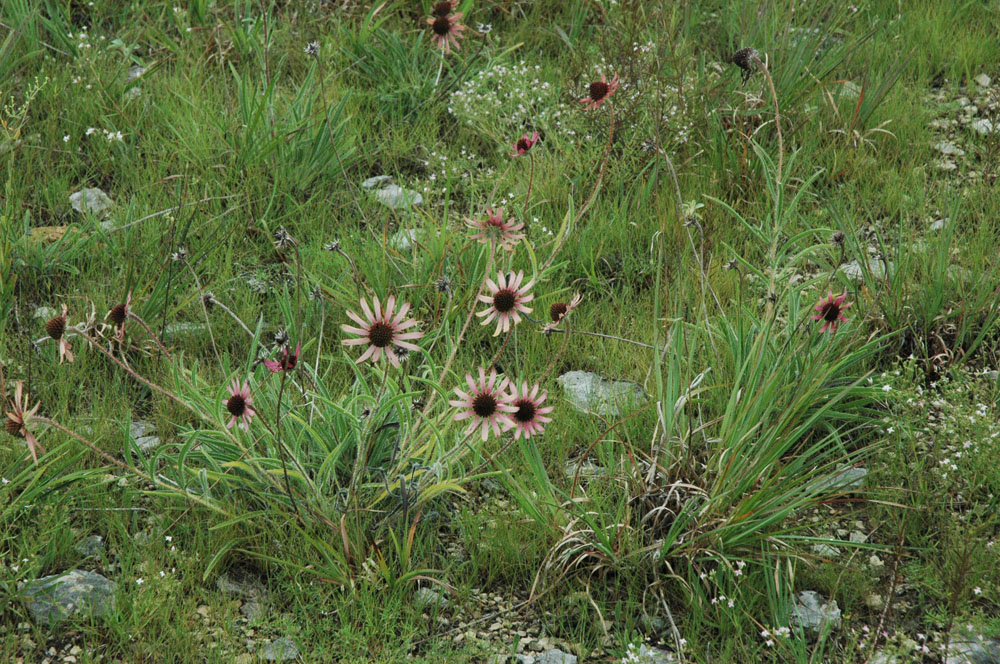
Glade vegetation
Our next stop was site 4, in the area where the boxtrap was placed the night before. Terry and I put out one malaise, one Lindgren, and one barrier trap here. The malaise was placed across a trail on the north side of the road and the other two traps were placed in the cedar/hardwood forest on the south side of the road.
We returned down the same road back toward the park (east) and put one malaise trap, one Lindgren, and one barrier trap at site 5 (36°05’45”N 86°21’27”W), all on the north side of the road. The malaise was placed across the glade-like trail and the other two traps were placed in the cedar/hardwood forest. While putting up the barrier trap, JoVonn collected a longhorn beetle on a Verbesina virginica plant, which was plentiful throughout the glades. The beetle interested Terry, who also found one.
We went back to the cabin and put one more barrier trap up in the woods behind the cabin. While we were there, Buddy Ingram, the interpretive specialist at the park, came by and visited. He told us about some prime glade sites and some interesting cave formations. We followed him to an area called the Vesta Glade Natural Area at 36°04’36”N 86°23’45”W in Wilson County. The front area of the glade had abundant forb populations including the Tennessee cone flower, Echinacea tennesseensis and other plants found at the other glades we had visited. Farther back was a grass dominated barrens area, and the entire area was surrounded by cedar/hardwood forests. A trail wound through the wooded area and continued through the glade.

Someone got a photo of me collecting
We then followed Buddy to an old quarry area in the state forest, which was quite interesting. The area was somewhat different than some of the other glades and was underlain by hollow rock areas. The limestone fame flower, Talinum calcarium, with its succulent basal leaves, was in bloom. This bizarre flower is amazing in that it appears to grow out of the rock. The exotic blackberry lily (Iris domestica) was blooming along the edges of the glade, as were several species of composites. Lots of ferns, mosses, and lichens were present as well.
After leaving this area, Buddy showed us two caves in the state park, Jackson Cave and Hermit Cave. We only had time to look around the entrances, but they were obviously fascinating caves. We then headed back to the cabin, where we collected a bit until supper.
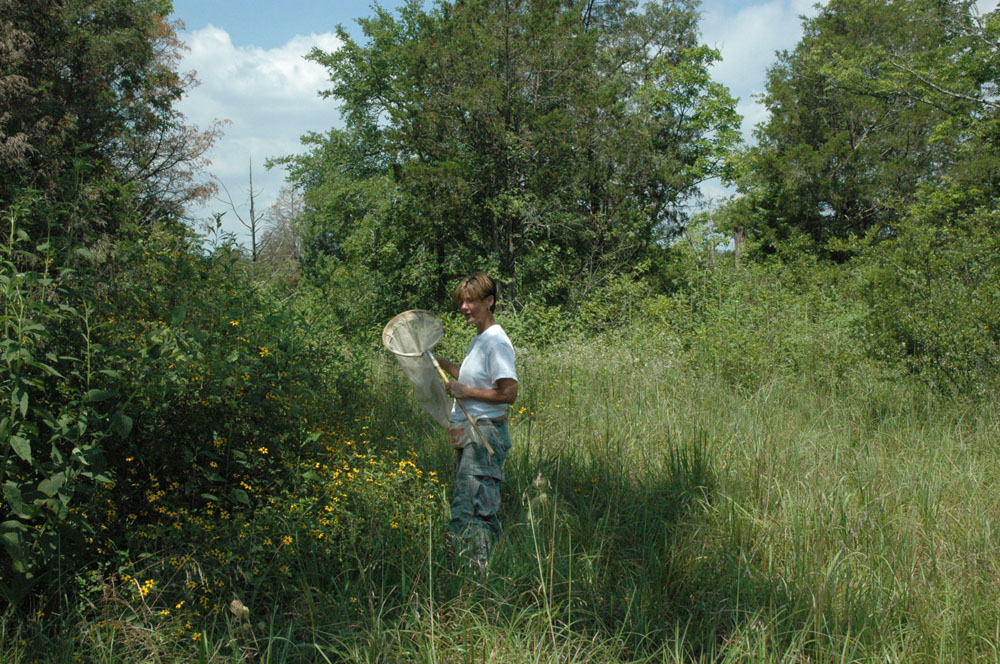
Beverly, catching bees on sunflowers
Following supper we put up sheets and blacklights at Vesta Glade. Temperatures were again cool and we had intermittent light rain, which eventually stopped. Clare put here sheet and blacklight up in the cedar/hardwood forest and we put up two sheets with lights in the forest, and two in the open glade areas. One was in an area dominated by forbes and the other was in a grassy barrens area. There were quite a few moths present, carabids, leaf hoppers, a few scarabs, and other assorted insects. It seemed like things were slowing down, especially for non-moths, so Terry, Beverly, JoVonn, and I headed back to the cabin at about 10:30 PM to check the sheet there. Richard, Sangmi, and Clare stayed about 30 more minutes and then joined us at the cabin.
Wednesday, 22 July 2009
Sometime during the night it had begun raining and we awoke to rain. As JoVonn walked outside to the truck for something, he noticed some ants that were moving in regular lines from one part of the sidewalk to the parking area about 3.5 meters away. We had seen a couple of the ants the other day and just thought they were some sort of Aphaenogaster species, without having looked very close. Because of their behavior, he put a couple under the scope and quickly discovered that they were army ants in the genus Neivamyrmex. We collected a good series and also took a short video of them.
About mid morning, JoVonn and I headed out to explore and collect at the Couchville Glade in Davidson Co. (36°06'04"N 86°31'46"W). Terry and Beverly collected along the trails in the state park and the others occupied their time pinning moths.
Although it was a good drive to the Couchville glade (about 30 minutes), we were pleasantly rewarded by a beautiful area with an abundance of plants in bloom. Lots of Tennessee coneflower, Rudbeckia sp., Erigeron sp., Helianthus sp., Verbesina virginica, Glade clover, gum weed, and many other flowers were in bloom. Apparently, Dalea foliosa also occurs there along wet areas. The entire area, which covers about 100 acres, is a mix of forb rich glades, grassy barrens, and cedar/hardwood forests. A one mile loop trail made it easy to walk through the area, and we spent a couple of hours there collecting and looking around.
After leaving the glade, we went back to the cabin with intentions of collecting there. However, we had a good rainstorm, which postponed our collecting. By the time supper was over, the rain had pretty much stopped, but it was essentially too late to go anyway and set up sheets. Therefore, we just put two sheets up along a wooded trail near the cabin and collected at them and the sheet at the cabin. Around the time we were eating, James Lewis, our student worker, came by to visit. Coincidentally, he was staying in nearby Lebanon, TN where he had a job interview. After he left, two entomologists, Nadeer Youssef and Josh Basham, from Tennessee State University dropped by to collect with us. Collecting was, like the other nights, very slow.
Thursday, 23 July 2009
The next morning, Terry, Beverly, JoVonn, and I went to explore some glades in Rutherford County. The first glade we visited was Stone’s River Cedar Glade (35°52’24”N 86°26’09”W) at the Stone’s River historic battleground site area in Murphreesboro in Rutherford County The interpretive specialist, John MacKay, showed us how to get to the site, as well as showing us a few other interesting spots. An F5 tornado had hit this region a few months earlier and they were still cleaning up after it. This was quite noticeable in the glade as many trees were down and random household debris items were strewn around the area, which was not overly extensive. Despite the relative small size of the glade, the collecting was good and we found quite a few things, especially beetles, bees, grasshoppers, but, other insects as well.

Terry, looking at a cerambycid beetle
Our next stop was the Manus Road Cedar Glade at 35°47’09”N 86°16’01”W in Rutherford County. We arrived at the glade at about 1:45 PM and it was in the upper 80’s F. At the entrance to the glade a pool of water resulting in runoff from a nearby pond was present with lots of small fish in it. These were the first fish we had seen in the glades. To get to the glade, we climbed the gate and walked down an old driveway, which let to a uninhabited house/building. At first we did not think the site was going to be very interesting, but it opened up into a nice glade dominated by Euphorbia corallata, Erigeron, and Houstonia purpurea. Some large populations of prickly pear cactus were also present, as were other glade plants. For some reason, possibly the time of day, the collecting here was not as good as the first site, although JoVonn did get at least one “good” grasshopper. At any rate, we didn’t stay overly long.
Our third site was the Flat Rock Cedar Glades and Barrens State Natural Area at 35°51’31”N 86°17’44”W on Factory Road in Rutherford County. We had visited this site in 1997 and remembered it being a nice place to collect. We decided to follow the trail and collect along it and the various glade opening along the way. Eventually, the trail opened up into a large glade, as well as many smaller ones and we collected lots of flies, beetles, Hymenoptera, and grasshoppers. Apparently, Terry and Beverly followed the purple trail, which was quite long, but JoVonn and I went down the purple/blue trail, which seemed to go on forever! Needless to say, by the time we got back to the truck, it was getting late. We called Richard and suggested that they set up the sheets without us, because we were going to be late.

A nice moss covered wooded area
We finally made it home, quite tired from trekking miles in the sun, got our gear together, then headed to the Couchville Glades to meet the other folks. Beverly was tired, so she stayed behind, but everyone else was again present, including Nadeer and Josh. Before getting to the glades, Richard had also put up a boxtrap at Vesta Glade. At Couchville, they put up four sheets. By the time Terry, JoVonn, and I arrived it was almost 9:00 PM. It almost wasn’t worth the 30 minute drive, as the collecting was less than spectacular. But, we collected representatives of what was at the sheets. We did not stay overly long and left around 11:00 PM. Several people also collected at the cabin sheet when we got back.
Friday, 24 July 2009
Richard once again got up early and retrieved the box trap and began sorting it. The trap catch was surprisingly sparse, and he was disappointed. Clare said her goodbyes before heading back to Florida. Sangmi and Richard stayed at the cabin, and Terry, Beverly, JoVonn, and I went back to the Couchville Glades to day collect.

Richard Brown, spreading moths
We stayed at the Couchville Glade until about 2:00 PM, as the collecting was quite good. Plenty of insects were flying around, visiting flowers, and lots of grasshoppers jumping and flying around. While chasing a grasshopper, I was chastised by a night hawk who appeared to be guarding a nest. Underneath a flat rock, I found a large spider with gray coloration dorsally and black ventrally. Temperatures were in the upper 80’s F again, and this was probably the best collecting day we had so far!
Our timing was good and soon after we left the site, it began to rain again. We spent the next couple of hours taking care of specimens, before going back out to collect on the trails at the cabin.
That night, we put up three sheets at the quarry glade area (36°05’01”N 86°24’`12”W) in the state forest, and Richard and I put up a box trap in the same area. Richard, Terry, JoVonn, Beverly, Sangmi, and I all collected at the sheets that night. Two of the sheets were in the open glade areas, and one was in the cedar/hardwood forest adjacent to the glade in an area with lots of moss, ferns, and white flower leafcup (Polymnia canadensis). Collecting at the sheets was again, very slow. Some small beetles came in early, with some larger ones appearing intermittently. Some decent micros [micro-lepidoptera] were there, but similar to preceding evenings, the sheets were dominated by an ash feeding crambid moth in the genus Palpita. These moths were so common that they were annoying! We watched as five individuals fed on a dead midge on the sheet. They looking like vampires, each with its proboscis stuck into the liquid hemolymph of the fly. After the temperatures dipped and the humidity level increased, we took the sheets down and went back to the cabin to collect at the sheet there.
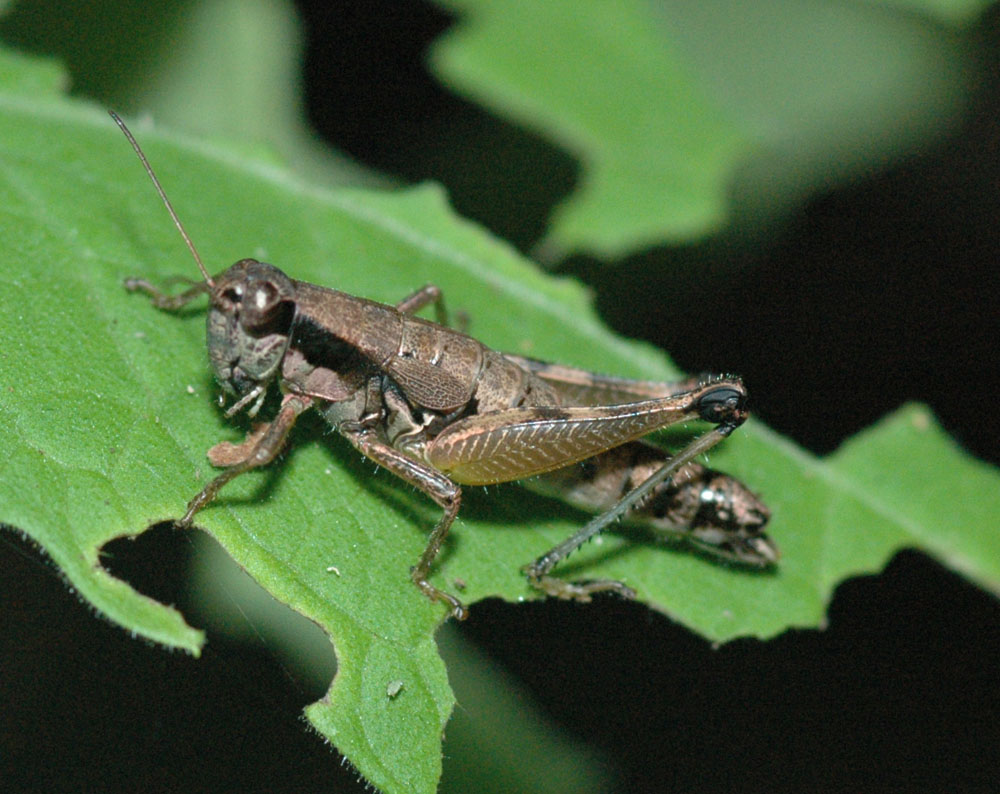
Melanoplus gracilis (female) roosting at night on leafcup (photo by JoVonn Hill)
Saturday, 25 July 2009
Richard once again arose early to retrieve the boxtrap, which he sorted, and Sangmi and he spent the rest of the day spreading moth wings. Meanwhile, Terry, JoVonn, Beverly, and I collected along the five mile long trail in the park near the cabin area. The trail wound its way through cedar/hardwood forests, oak-hickory-sugar maple forests, and open glades. This was the warmest day of the trip with temperatures in the upper 80's (F) and day collecting was good. During this time, Terry got a chance to beat some trees and shrubs.
When we got back to the cabin, JoVonn, Terry, and I met Buddy, who showed us a nice glade on some private property adjacent to the park down a road called Burnt House Anx. Apparently, Buddy used to own this property, and he had planted lots of Tennessee coneflower there. The coneflowers fared well and spread throughout the area (about 20 acres). JoVonn collected a nice grasshopper there. After exploring the area, we left and got some lunch at the cabin.
After lunch, Terry and I went back to the state forest and took down all of the traps. JoVonn accompanied us and collected and photographed insects. The malaise traps were not brimming with insects, but they were relatively full. Hopefully, some interesting species made their way in. I also picked up two large bags of soil and leaf litter from site 6 from bases of trees. On the way back to the park, we stopped at a cave called "Cricket Cave", which is known for its large populations of cave (camel) crickets. We went in with our headlights and collected a few of the crickets near the entrance. It was not as easy as it sounds, because the crickets were on the rock above our heads and were not overly interested in being collected. By the way, they bite. The cave itself was about two meters in height and about 1.5 meter wide, although it did spread out here and there. When we got back to the cabin, we told the others about it, and Beverly and Sangmi wanted to see it, so we showed it to them.
Since it was our last night on the trip, we decided to blacklight in the park at the cabin sheet and at two sheets on the nearby trail. The common crambid moth again overwhelmed the sheet, but the night proved to be more interesting for beetles than previous nights. Terry collected more cerambycids that night than he did all of the week before. I believe about 16 species were collected for the entire week. Just before we began collecting, Buddy came by for a visit. He brought his banjo and played for a while with Richard, who played his harmonica. The two of them together with their many years of experience played some wonderful music.
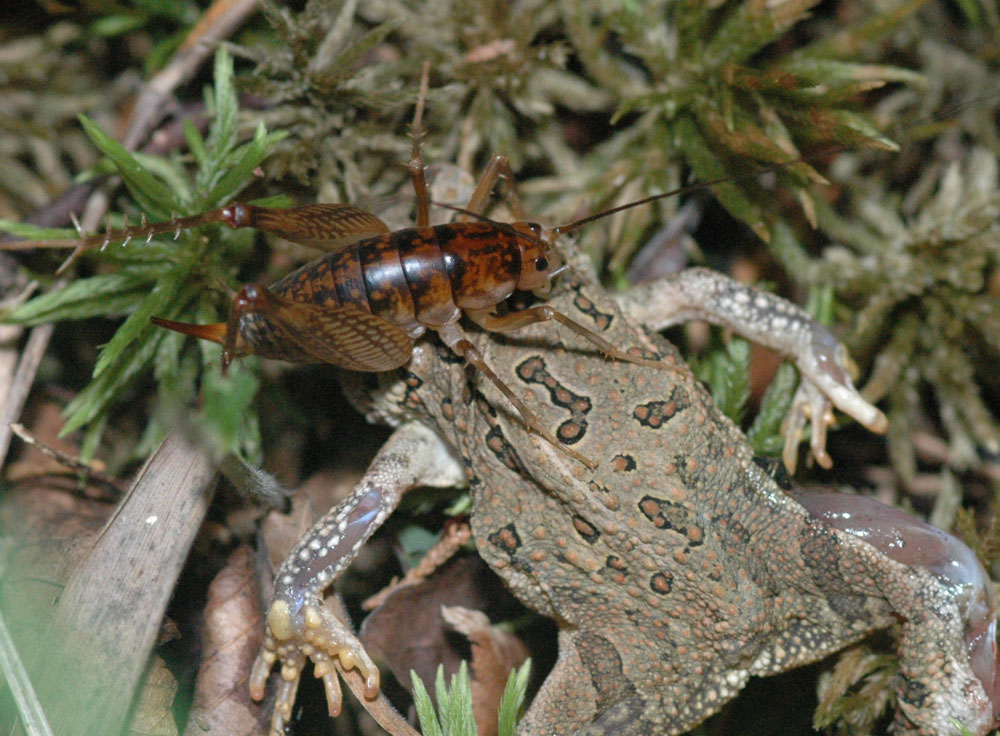
Camel cricket feeding on dead toad (photo by JoVonn Hill)
Overall, the trip proved to be a success. Moth collecting was not as fruitful as we had hoped, but some of the other insects collected during the day were good finds. We collected at least 3 new state records that we were aware of right aware, and others may turn up when they are identified later. Collections of grasshoppers were exceptionally good, and we found 17 species during the week!
Sunday, 26 July 2009
Sunday morning marked the end of our trip, and we loaded up the trucks and headed back to Mississippi State.
Cedar Glade Sites 2009
Cedars of Lebanon State Park – Cabin 2 & trail area nearby (blacklight/mv lamp -20-25 July, Lindgren, barrier)
TENN., Wilson Co.
Cedars of Lebanon S.P.
36°04’52”N 86°18’55”W
Cedars of Lebanon State Park (Buddy's old place, borders state park)
TENN.,Wilson Co., near
Cedars of Lebanon S.P.
36°05'03"N 86°18'36"W
Cedars of Lebanon State Forest Site 1
TENN., Wilson Co.
Cedars of Lebanon S.F.
36°05’44”N 86°21’56”W
Cedar of Lebanon State Forest Site 2 (blacklight/sheets - 20 July)
TENN., Wilson Co.
Cedars of Lebanon S.F.
36°05’26”N 86°22’34”W
Cedar of Lebanon State Forest Site 3 (malaise, LIndgren, barrier)
TENN., Wilson Co.
Cedars of Lebanon S.F.
36°05'44”N 86°21’23”W
Cedar of Lebanon State Forest Site 4 (Boxtrap on 20 July, malaise, LIndgren, barrier)
TENN., Wilson Co.
Cedars of Lebanon S.F.
36°05’21”N 86°22’45”W
Cedar of Lebanon State Forest Site 5 (malaise, barrier)
TENN., Wilson Co.
Cedars of Lebanon S.F.
36°05’45”N 86°21’27”W
Cedar of Lebanon State Forest Site 6 (Quarry Site) (boxtrap and sheets on 24 July)
TENN., Wilson Co.
Cedars of Lebanon S.F.
36°05’01”N 86°24’12”W
Cedar of Lebanon State Forest Site 7 (Cricket Cave)
TENN., Wilson Co.
Cedars of Lebanon S.F.
36°05’23”N 86°23’09”W
Couchville Glade (blacklight on 23 July)
TENN.,Davidson Co.
Couchville Glade N.A.
36°06'04"N 86°31'46"W
Stone’s River Cedar Glade
TENN.,Rutherford Co.
Stone’s River Glade
35°52’24”N 86°26’09”W
Manus Road Cedar Glade
TENN..Rutherford Co.
Manus Road Glade
35°47’09”N 86°16’01”W
Flat Rock Cedar Glades and Barrens State Natural Area
TENN.,Rutherford Co.
Flat Rock Cedar Glade
35°51’31”N 86°17’44”W
Vesta Glade Natural Area (blacklight 21 July, boxtrap 23 July)
TENN.,Wilson Co.
Vesta Cedar Glade N.A.
36°04’36”N 86°23’45”W
The habitats were: "Cedar Glade" and "Cedar-Hardwood Forest"
A List of Some Flowering Plants Found in the Cedar Glades during our trip (insects were collected on some of these)
Acanthaceae
Ruellia spp.
Apiaceae
Daucus carota - Queen Anne's lace, wild carrot
Asteraceae
Carduus nutans-nodding thistle, tall
Echinacea pallida-pale coneflower
Echinacea tennesseensis-Tenn. coneflower
Erigeron spp.
Grindelia lancelata- (gumweed)
Helianthus spp.
Liatris aspera
Liatris squarrosa
Polymnia canadensis - white flower leafcup
Rudbeckia hirta-black eyed susan
Ratibida pinnata-prairie coneflower
Silphium bipinnafidum
Solidago spp.
Verbesina virginica - white crownbeard
Cactaceae
Opuntia humifusa-cactus
Campanulaceae
Lobelia gattingeri-purple
Caryophyllaceae
Arenaria patula-white glade sandwort growing on rock outcrops
Clusiaceae
Hypericum frondosum-shrubby
Hypericum sp.
Crassulaceae
Sedum pulchellum-stonecrop
Euphorbiaceae
Euphorbia corollata
Fabaceae
Astragalus bibullatus - Pyne’s ground plum
Astragalus tennesseensis-Tenn. milkvetch
Baptisia spp.
Dalea foliosa-rare
Dalea gattingeri-Gattinger's Prairie clover
Desmodium illinoensis
Melilotus alba
Melilotus officinalis
Gentianaceae
Sabatia angularis - rose pink
Iridaceae
Iris domestica - blackberry lily, leopard lily (exotic species)
Lamiaceae
Blephilia ciliata
Satureja glabella-glade mint or glade savory
Scutellaria parvula-small skullcap
Onagraceae
Oenothera missouriensis-large yellow flowers, Missouri primrose
Polemoniaceae
Phlox spp.
Portulaceae
Talinum calcarium limestone fameflower
Rubiceae
Houstonia purpurea
Scrophulariaceae
Penstemon spp.
Verbenaceae
Verbena canadensis-a large flowered species
Verbena simplex
A Few Common Trees and Shrubs
Aceraceae
Acer saccharum - sugar maple
Anacariaceae
Rhus aromatica
Caprifoliaceae
Symphoricarpos orbiculatus-coral berry
Cupressaceae
Juniperous virginiana-eastern red cedar
Fagaceae
Quercus spp.
Junglandaceae
Carya spp.
Oleaceae
Forestiera ligustrina-glade privet
Rhamnaceae
Rhamnus caroliniana-Carolina buckthorn
Links
List of ant species collected at Cedars of Lebanon State Park



